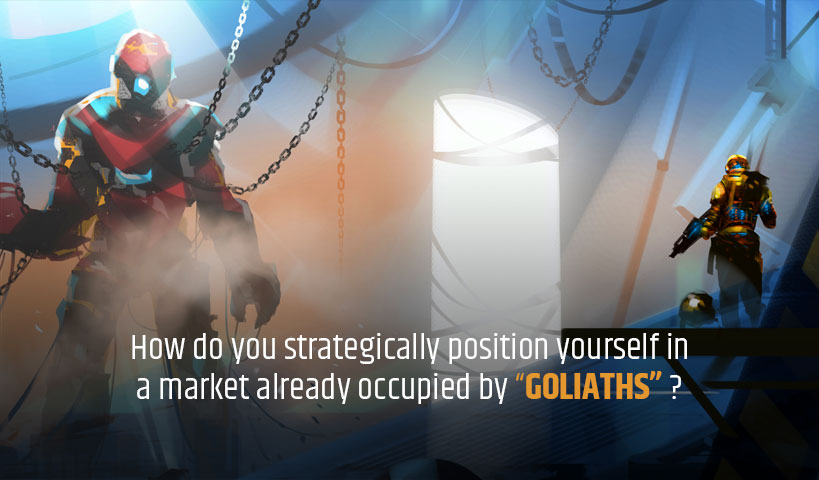
We are currently working with a client on a strategic position and branding mandate. This is the launch of a new technology platform. It combines artificial intelligence and the expertise of specialists in a market that already has its leaders and challengers.
They are mostly well-established multinationals (Goliaths), with a roadmap that ensures the credibility and position of each of these players.
So how will our client make its mark and strategically position themselves in a growing market already occupied by “Goliaths”? They will naturally behave like David by being bold, agile and even creative in order to break into the market. (For confidentiality reasons, we cannot supply more details that would allow us to identify the client)
The research and analysis necessary for this type of mandate has uncovered an angle of attack that the client had not seen before. That is to say, it will fight in a territory less occupied and not protected by competitors.
In the process of analyzing the competition with Gartner’s axes of capacity and strategy, we found another axis of positioning usable for our client. And it corresponds to a very specific strategic area of activity.
We continued our analysis. With the indispensable collaboration of the client in our understanding of this new platform, the light switched on!
Not only was our client innovating in terms of the complexity of data collection, but their platform was integrating data related to environmental considerations; what none of the “Goliaths” had yet integrated.
This is where the platform stands out but to such an extent that it creates a new product category in the strategic business area.
By using this axis of positioning with one of the axes proposed by Gartner where our client defends itself very well, the competitive landscape and the possibilities are not at all the same. The position you want to occupy in the market is suddenly very advantageous.
The model that David A. Aaker calls “Brand relevance”
This model creates the conditions for rapid market adoption of innovation. Having used it several times in past launches, I have measured all its strengths.
It allows the brand to dissociate itself from competing products to such an extent that it occupies its positioning alone in the minds of customers and the market. It is not the first in a category but, the only one in its category or subcategory.

Aaker’s book title: “Brand relevance making competitors irrelevant” says a lot about the importance of innovation and also knowing how to exploit it in marketing!
The objective is simple and ambitious and for some, daring: fight the “Goliaths”. And win by decreasing their importance in a product category! The competition will not disappear, but it will be so distant that it will not be “present”. That’s basically the promise of this model and that’s what we use.
Innovation in product and service development
Innovation in the development of an offer that knows how to create a category or subcategory generates opportunities for marketing teams to occupy and win a market. It doesn’t all stop there.
We must then protect our market, our territory, and thanks to the collaborative work of all the functions of the company, we ensure that we create barriers of entry for competition. Also, to define what this new category is and to manage it in front of the market. This requires to be implicitly customer-centric as opposed to being product-centric. What our client understood!
Indeed, this new product is developed from needs not met by the market. And also by our client’s specific expertise in design, implementation and support. It is a harmonious co-creation where the customer is central. They are involved in the development of the product. This will allow them to make strategic decisions with confidence.
Brands that choose to create and manage new categories are more likely to thrive. While others who fight for the same territory lose a lot of energy to stay alive.
The logical continuation of our process leads us to develop the brand platform from which its nominal identity (the name) and its visual identity will be declined.
A work of “branding” in B2B should not be limited to a creative process. By providing a framework for reflection based on such an approach, the result of the creative process will be more efficient.
If you need support in a product or service launch, we will be happy to discuss it with you.
Have a nice day!




